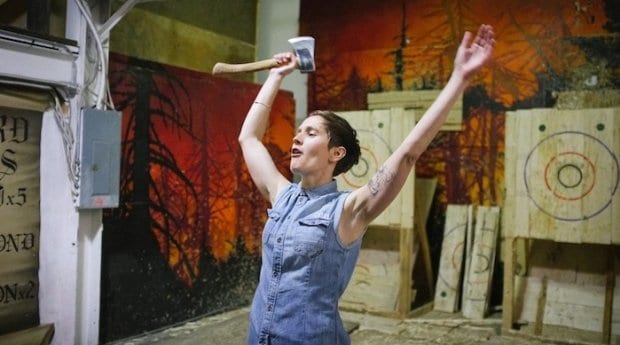All eyes are on the axe-wielding man in the middle of the room.
Kevin Villasenor is poised, his body centred on the wooden target board in front of him. Behind him, a raucous crowd cheers him on, awaiting his next move. AC/DC’s “Back in Black” blares from an overhead speaker — fitting, as Villasenor’s slim, tall figure is adorned in a black shirt and dark blue jeans.
He assumes his position: the axe, pointed perpendicular to the target; his shoulders, square with a mural of icy blue mountains behind the tall wooden board in front of him; his eyes locked on the bull’s eye.
His moves are methodical. One: he rocks the axe between his palms. Two: he lines up the shot. Three: he tosses the axe, his arms spread behind him like a bird in flight as the handle is released. The axe spins in the air, end over end, until the blade hits the target — smack in the middle, buried in the wood.
The crowd cheers. It’s a bull’s eye.
After retrieving his axe, Villasenor clinks it against his competitor’s — a sign of sportsmanship. He flashes a quick smile at the man filming him; he’s won the first game of the match.
But Villasenor is not an expert: he’s neither a lumberjack, nor a World’s Strongest Man competitor. In fact, he’s just one of a handful of LGBT Torontonians, known as the Queer Axe Folk (QAF), who come out every two months to try their hand at what one Toronto blog has dubbed the city’s “newest homegrown sport.”
A competition created by burly lumberjacks to show off their masculinity and strength, axe throwing has previously had little appeal among gay people. And yet, this new breed of axe throwers is finding a sense of community through the sport — one the typical Village gathering just can’t match.
***
QAF founder Melanie Hider formed her group of throwers in November 2013 — it now numbers about 40 people. The QAF was jokingly named after the early-2000s TV series Queer As Folk, and it contains a hodgepodge of competitors on the LGBT spectrum.
Similar to darts (“but not,” Hider loves to joke), the sport requires competitors to toss axes at a giant wooden target about four metres away, aiming for the bull’s eye. All QAF competitors are novices (no professionals are allowed to participate); most competitors learn the ropes just 20 minutes before facing off in tournaments against each other.
Axe throwing has historically been incredibly competitive. It originated in logging sports as a “strongest man competition” among lumberjacks. The first logging competition dates back as far as 1870 in Australia. The sport then made its way to North America in the early 20th century and took hold among lumberjacks.
But recreational axe throwing entered the mainstream only recently, with the advent of the Backyard Axe Throwing League (BATL), a Toronto company that has hosted axe-throwing competitions in two downtown locations. Founded by Matt Wilson in 2006, BATL has more than 100 regular league members in addition to one-timers who give throwing a try for parties.
The QAF held its inaugural event at BATL’s 425-square-metre facility in Toronto’s west end, described by online reviewers as a hotbed of “sawed wood and freshly sharpened steel.” A rough-around-the-edges venue, the atmosphere differs from the typical glitzy hangout on Church Street.
Hider says it makes for a perfect social space.
A bubbly Johannesburg native who became infatuated with the sport after trying it at a friend’s birthday party two years ago, Hider says she wanted to establish the type of relaxed social space she thinks Toronto’s LGBT community is lacking. “I wanted to create a queer event where people would socialize and bring people together and bond,” she says.
As a result, Hider says, the competition becomes more about trying to hit targets than winning. Players cheer each other on and no one roots for any one specific competitor. In videos shot during the late-November night of the QAF’s first event, the crowd “oohs” and “ahhs” at every throw of an axe — even when the throwers are complete strangers.
Villasenor, who is soft-spoken and reserved, says that support comforts him while throwing. “I never felt at unease,” he says.
“It felt good to throw when they were cheering.”
***
Some say it’s revolutionary that the group has thrived at BATL.
Sheila Cavanagh, coordinator of sexuality studies at York University and playwright of the Queer Bathroom Stories, commends the QAF for breaking the boundaries of sports often inaccessible to LGBT people, like wrestling, football and axe throwing. “It challenges our ideas about who is athletic and who isn’t athletic,” she says. “It disrupts myths we have that women don’t know how to use an axe or gay men don’t know how to throw an axe.”
“[We] begin to see gay men and queer women as strong.”
Hider, though, plays down the academic analysis: “It’s really just about the social aspect,” she says.
Still, Cavanagh’s assessment appears spot on. For one, women dominated the first QAF event (“I thought it might be all burly men,” Villasenor confesses), a sign that perhaps the group has shifted power dynamics more than its members let on. That the group has had success outside the boundaries of the Village is, in Cavanagh’s words, “remarkable.”
“It’s absolutely inspiring,” she says.
***
Villasenor’s first attempt at axe throwing turns out to be a successful one. He places fourth at the event, with ambitions to win the top prize — an axe with a handle wood-burned by Hider herself — in the next tournament.
Behind the axe, Villasenor’s nervous demeanour falls away; he becomes one with the hollering crowd and classic rock music. The more targets he hits, the more confident he becomes.
It all seems to be part of Hider’s master plan: to build friendships among strangers, to have fun. The next stop for the QAF, she hopes, is an event at Toronto’s annual Pride celebration.
“It’s really one of those life experiences you need to tick off your bucket list,” she says. “It’s unlike anything else.”
Visit the QAF Facebook page for more info.


 Why you can trust Xtra
Why you can trust Xtra


